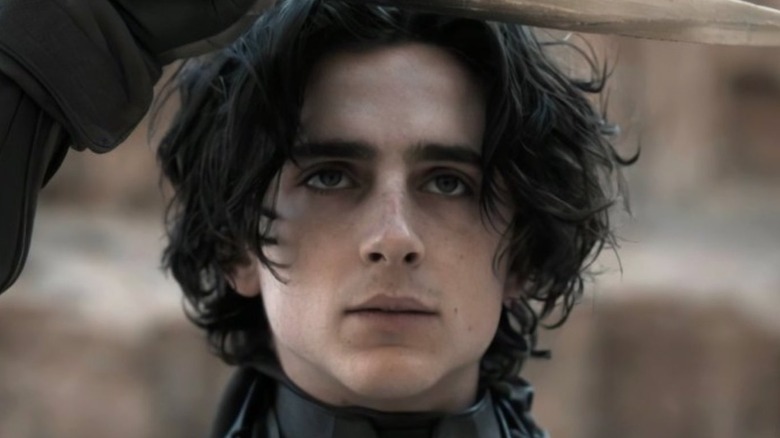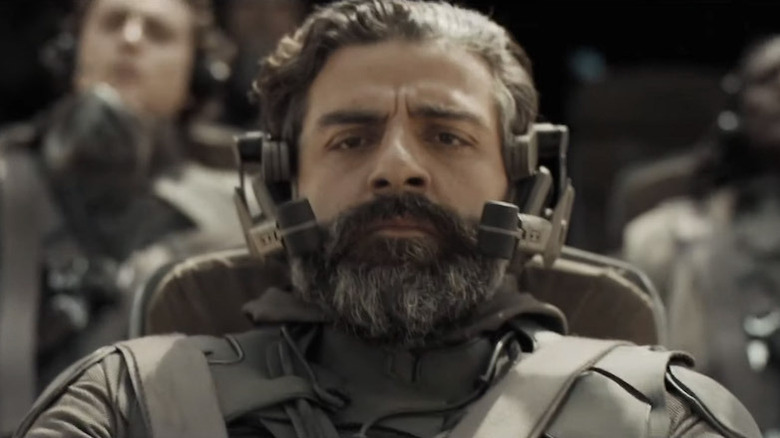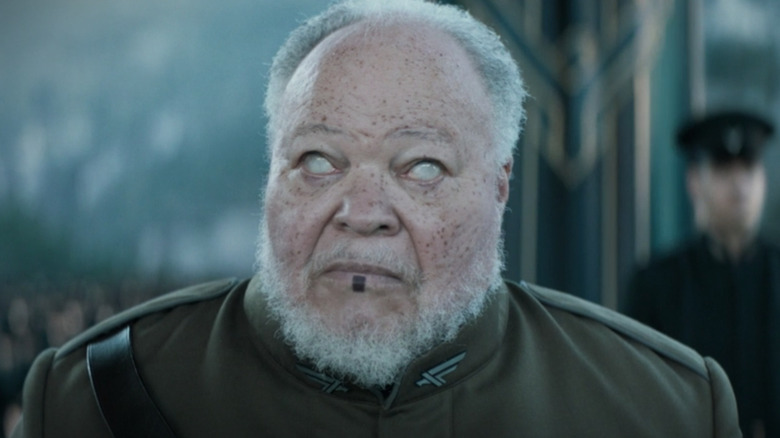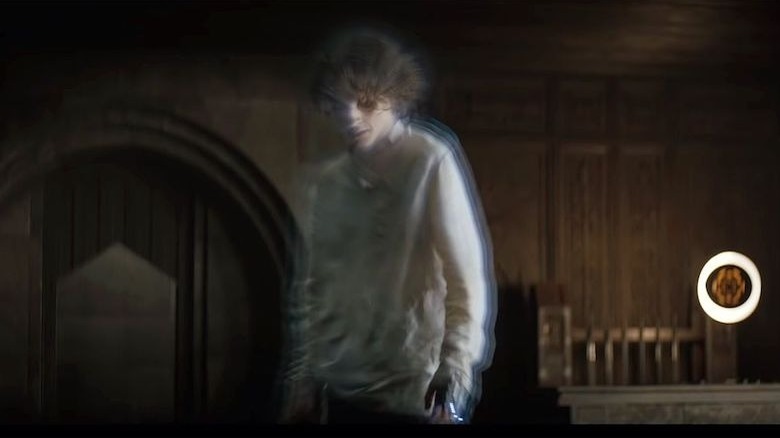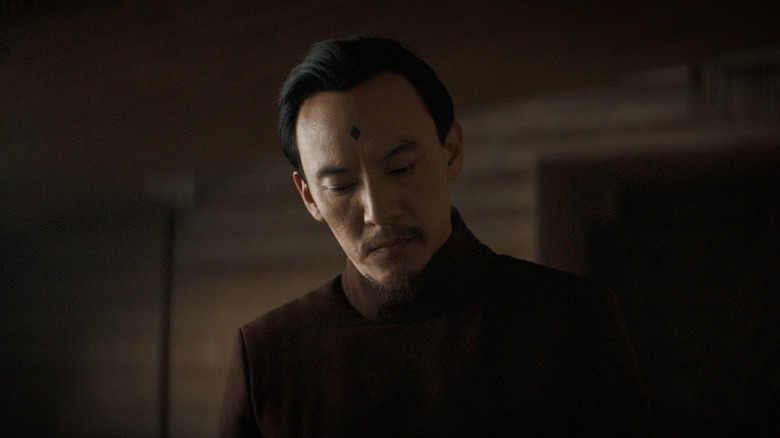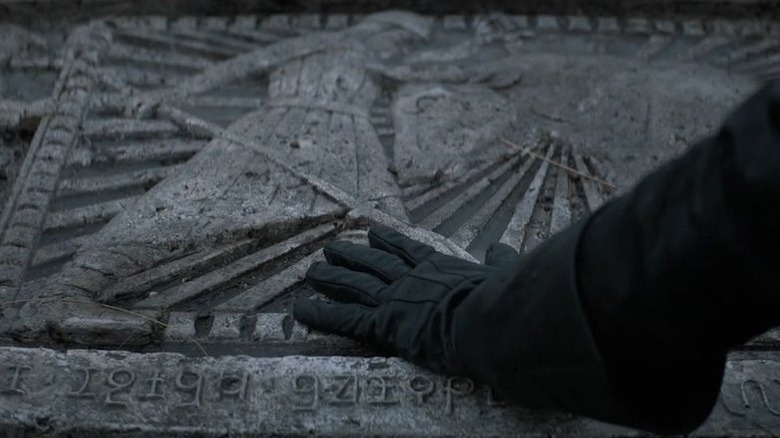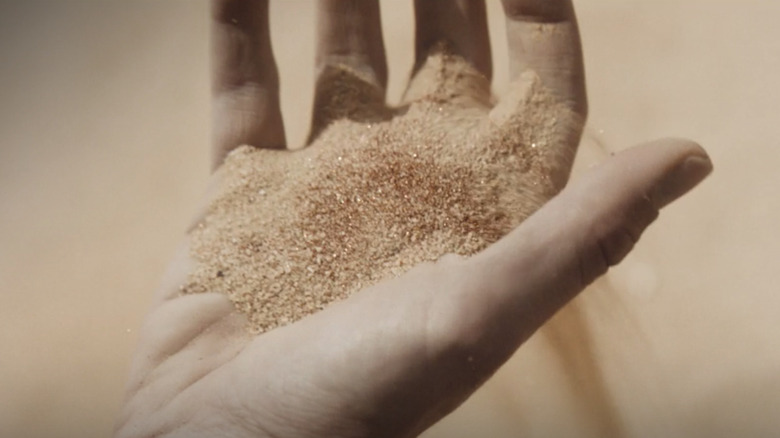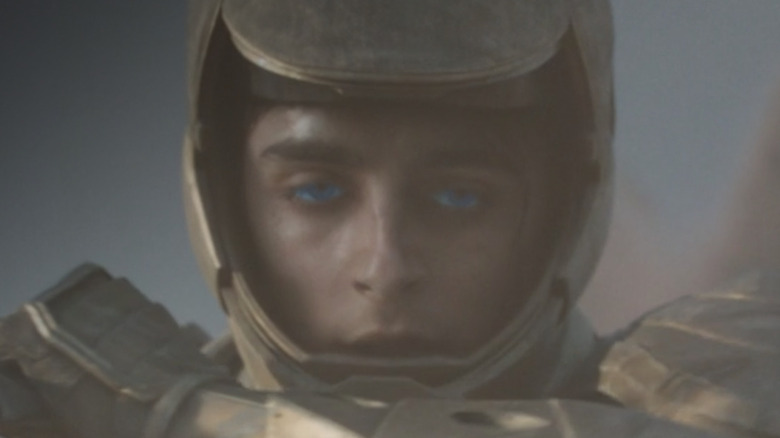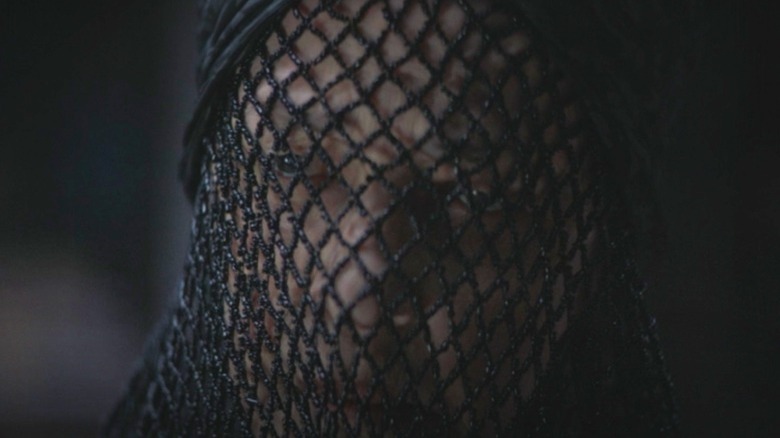Small Details You Missed In Dune
Spoilers abound for Denis Villeneuve's "Dune"
"Dune" is finally in theaters, and boy oh boy has it been a long wait. Like most huge blockbusters due for release in 2020, the Warner Bros. film has been delayed several times in the last few years thanks to the ongoing pandemic. But fans have finally been able to visit the planet Arrakis for themselves, with Timothée Chalamet leading an impressive cast as Paul Atreides.
Critically acclaimed director Denis Villeneuve is in the director's chair, bringing all his grand sci-fi expertise over from both "Arrival" and "Blade Runner 2049." Adapting the original novel by Frank Herbert is no small feat, and it's impressive that Villeneuve has been able to do it justice in the way that he has. He's clearly impressed plenty of critics, since it currently has an 87% rating on Rotten Tomatoes. It's a dense story, but the director masterfully translates it to the big screen without compromising its complex ideas and philosophical themes. It's also a big universe, but the director navigates it with ease. That said, even the first half of the novel that "Dune" adapts is loaded with content and esoteric context, and since "Dune" the film doesn't come complete with a massive alien glossary in the back, much of the worldbuilding is communicated visually or in passing dialog.
In service of fully unpacking this masterpiece, here are some of the small details you might have missed in "Dune."
There are no computers anywhere in the Dune universe
One of the most surprising parts of "Dune" that goes relatively unnoticed is that there aren't any computers in the universe — well, not as we know them anyway. Sure, there's basic technology that relays information for the user, but there's no smart tech or artificial intelligence to assist with space travel, and absolutely no processing machines capable of executing computation. Even the ornithopters — those bird-like planes flown by the Atreides — rely entirely on the reaction speed, eyesight, and navigational skills of their pilots. We even see Paul at one point using a kind of futuristic abacus to straighten his path through the desert. To put it simply, the technology in "Dune" feels awfully analogue. It's a science-fantasy aesthetic lifted straight from the source material, which went on to leave a serious imprint on the genre, inspiring legions of imitators — George Lucas' "Star Wars" most famously.
But why? Society is clearly very advanced thanks to the huge space ships used by the Great Houses to ship troops and spice across the universe. This is a truly interstellar civilization set in the far future, and with not as much as an Apple 3 computer to show for it. Here's the context: Thousands of years before the events of "Dune," humans waged war across the universe with a malevolent A.I. called Omnius who rose to take advantage of the fact that humanity had become reliant on "thinking machines." The 2002 novel "Dune: The Butlerian Jihad," published after Frank Herbert's death and written by his son, Brian, and sci-fi author Kevin J. Anderson, kicks off a trilogy about this crusade to free the universe from the malevolent computers that had penetrated every facet of modern life.
As per Fandom, a new idea was created by the survivors of the war: "Man may not be replaced." This is largely why the Spacing Guild is such an integral part of the Imperium — because there aren't any "thinking machines" to oversee space travel. Instead, the mutated Spacing Guild Navigators rely on spice from Arrakis to grant them the ability to fly FTL ships called heighliners through "fold space." There are no computers in "Dune" because they are forbidden by interstellar law.
Thufir Hawat's exorcist eyes
When House Atreides is called upon to take over stewardship of Arrakis, there's a grand formal ceremony on the planet Caladan to mark the occasion. The Padishah Emperor's herald arrives in a behemoth ship, along with members of the Spacing Guild and even one of the Bene Gesserit. The proceedings are kept relatively short, but during the exchange we see a few small details that carry outsized importance. When Duke Leto asks his advisor Thufir Hawat (Stephen McKinley Henderson) how much the proceedings cost the Emperor, Thufir's eyes glaze over to a milky white color as he works out the exact figure. It's a little odd, but it's key moment of worldbuilding in "Dune."
Although it's never directly explained in the film, Thufir is a Mentat. Mentats are extremely intelligent people who have been conditioned to hold vast amounts of knowledge and execute advanced computations as flesh-and-bone replacements for those verboten "thinking machines," which have been outlawed for thousands of years at this point. Thufir isn't the only Mentat in the film, either, as Piter De Vries (David Dastmalchian) is yet another representative of the order. Piter works for Baron Harkonnen (Stellan Skarsgard) as his advisor, and even oversees the Sardaukar attack on House Atreides, before falling victim to Leto's poison tooth.
Why isn't any of this context provided? It seems like Villeneuve made a key decision to prevent his film from getting bogged down in heaps of exposition — a savvy one, since death by exposition has been a historical risk of adapting "Dune." Instead, he trusts his audience to assemble the necessary plot elements from visual motifs and context clues. That's why we see Thufir perform a computation, but never hear the word "Mentat," which might beg further elucidation.
Denis Villeneuve's "Dune" doesn't reveal what happens to Thufir, so audiences will just have to wait for Part II — or read the book — to find out.
The slow blade penetrates the shield
Fear might be the mind killer, but the slow blade penetrates the shield. Although the personal shields are good for deflecting hard projectiles, they leave the user vulnerable to slow-moving handheld weapons. Gurney Halleck (Josh Brolin) warns Paul about this in the training scene early on in the film, and even shows him that immediately going for a killing blow can also lead to defeat. This is why fencing and swordplay have become integral skills for soldiers, while guns and other larger incendiaries have been relegated to space and ship-to-ship warfare.
It also adds an element of elegance to the universe, making war an incredibly personal thing, because soldiers and commanders have to face their opponents directly on the battlefield. Duncan Idaho (Jason Momoa) and Gurney are both incredibly gifted swordsmen, moving their weapons fast enough to catch the enemy off-guard — but slow enough to penetrate the shield. It's a delicate dance, unique to the combat aesthetic of "Dune."
Of course, it isn't just swords and knives that can slowly break through the shield, the remotely piloted Hunter-Seeker can pierce its defenses using a tiny needle filled with lethal venom. Dr. Yueh (Chang Chen) is also seen using a notable, slow-moving projectile to drill through Duke Leto's shield, paralyzing him for Baron Harkonnen. The world of "Dune" is a pretty hostile place.
The diamond tattoo on Dr. Yueh's head
Dr. Yueh is a slippery figure in "Dune," as he ultimately betrays House Atreides to the Harkonnens, believing that they're going to free his wife, who they've been systematically torturing, "taking her apart like a doll." Unfortunately, as Yueh learns in the most pointed possible way, it's never wise to a make a deal with Harkonnens.
He attempts to mitigate his sin by giving Duke Leto the poison tooth to deploy against the Baron, as well as packing a survival kit for Paul and Jessica (Rebecca Ferguson) on the ornithopter they ultimately wrest from Harkonnen control. He marks the kit under Paul's seat with his diamond insignia, which is also tattooed on his forehead. It's clearly not a fashion choice; in fact it's closely tied with his profession as a Suk doctor.
Dr. Yueh trained at the Suk Inner School, the graduates of which become skilled doctors who wear silver rings at their shoulders and a black diamond tattoo on their foreheads as symbols that they've completed an advanced conditioning protocol that prevents them from betraying their patients or violating their oath. It's this Suk mark that leads Leto to depend on Yueh without performing his proper due diligence. Only a Suk could gain the unconditional trust of Duke Leto, and so become the perfect mole for the Baron Harkonnen.
So how did Yueh break his conditioning? It's never explained in the film, but in the books and companion materials, we learn that the Harkonnen Mentat, Piter, found a way to breach the Suk conditioning by kidnapping and torturing Yueh's wife Wanna. By applying such unthinkable psychological pressure, Piter created an opening for Yueh's oath to protect his wife to supersede his oath of loyalty to his patients. Dark stuff.
The bull imagery associated with House Atreides
House Atreides is one of the most noble houses in the universe, and has plenty of support throughout the Imperium, so it's understandable why the Emperor is scared of Duke Leto and his family. The Atreides name carries weight throughout the galaxy. But why all the bull symbolism? We first see a carving of a man fighting a bull at the site of Paul's grandfather's grave. Leto mentions that his father was killed fighting a bull, so maybe this carving is just a tribute? But then we see a bull's head again, hanging in the Atreides palace on Caladan. The totem is important enough for them to box up and take with them to Arrakis, where we also see Paul playing with a bronze statue of a bull and bullfighter. Turns out: This isn't just any old bull.
The Salusan Bull is famous in the history of House Atreides mainly because Leto's father Paulus Atreides was killed by one during a bullfighting match. The Salusan Bull is notorious for its anger and violent temperament, so Paulus clearly enjoyed the wilder side of life. In the books, the bulls are described as having multiple horns and two brains, but the bull head seen in the 2021 film only has two horns, which honestly seems like a missed opportunity.
The spice triggers Paul's visions - and expands them
Very early in the film we're introduced to an aspect of Paul's character that really makes up the nuts of the story, though you might not realize it from "Part I." While still on Caladan, Paul is beset by vivid dreams that seem to trouble his mother and attract the attentions of the amoral Bene Gesserit. In these dreams, Paul sees war; he sees Arrakis; he sees the death of Atreides champion Duncan Idaho; he sees a girl in a stillsuit who looks a lot like Zendaya. As we know from the back half of the movie, all of these dreams come to pass, and Paul ultimately meets the Zendaya-looking Fremen girl named Chani (the daughter of Imperial Planetologist Liet Kynes).
There's a very brief moment in the film related to these visions that's easy to miss. It happens when Paul runs out into the desert to rescue a crew of spice miners under threat of wormsign. Sand kicked up by the approaching worm swirls around Paul and Gurney Halleck, and in that sand we see golden motes flickering — Villeneuve's visual cue for the presence of spice. This is the moment in the film when Paul gets his first large dose of the ambient spice that saturates the deep deserts of Arrakis. The spice awakens Paul's latent powers of prophecy. From this point on, his prophetic dreams become waking visions, and Paul begins to recognize his mother's Bene Gesserit hand in making him some kind of "freak."
The spice doesn't cause Paul's power of prophecy — that's all the result of the Bene Gesserit breeding program and Jessica's decision to defy her order and bear Duke Leto a son — but its regular application does awaken and sharpen the ability that will become the Atreides' blessing and curse for the next several millennia.
Paul has Fremen blue eyes in his vision of a future war
In one of Paul's waking visions, you might have noticed a strange physical attribute. Instead of Timothée Chalamet's typical tawny gaze, we see Paul Atreides fighting for Arrakis with the bright blue-on-blue eyes of the indigenous Fremen. But how is this possible?
As we will no-doubt discover in the second half of Villeneuve's adaptation, the blue-on-blue look that's so en vogue in the Fremen sietches is no genetic marker. It can happen to anyone after prolonged exposure to the spice. The spice is everywhere in the deep deserts of Arrakis. It's in the air the Fremen breathe, the water they drink — they cook it into their food. Aside from the obvious health benefits, it turns their irises and sclera a glowing shade of blue.
When the film ends, Paul and Jessica walk off with Stilgar's Fremen to return to Sietch Tabr. Paul tells his mother that his path goes through the desert. If that path is long enough, he's going to wind up with blue eyes — just like in his vision.
The Bene Gesserit cleared a path for Paul and Jessica in a big way
After the Reverend Mother Gaius Helen Mohiam pays a visit to Paul on Caladan with a very nasty present, she makes an off-hand comment to Jessica that "a path has been cleared" for them through Arrakis. In hindsight, this might seem like the height of sarcasm, since we know the Reverend Mother of the Bene Gesserit was simultaneously conspiring with the Harkonnens to murder the Atreides (excepting Jessica and Paul).
It's actually a more important line than you might think, as it provides the connective tissue between a few more strange and disparate occurrences throughout the film. To wit, consider Shadout Mapes' religious fervor after presenting Jessica with the crysknife during what is ostensibly her interview to become a maid; Liet and Stilgar's suspicion that Jessica and Paul satisfy some kind of prophecy, and that Paul might be the Fremen messiah; and Stilgar's use of the term "sayyadina," which he applies to Jessica after seeing her Bene Gesserit skills.
All of these events are part of the "path" that the Bene Gesserit cleared for Jessica and Paul. A Bene Gesserit initiative known as the Missionaria Protectiva seeds primitive cultures with Bene Gesserit symbols and rituals so that if a sister in trouble stumbles upon them, she might able to con her way into being revered as a God or, at least, some kind of messiah. The Missionaria Protectiva touched the Fremen, which is why they consider a "weirding woman" like Jessica to be some kind of anointed priestess — a sayyadina. Jessica knows the right words to say to set Shadout Mapes wailing, because Shadout Mapes' entire faith is largely a construct of the Bene Gesserit.
It may seem a cruel tactic, but the Fremen are about to turn this con job on the Bene Gesserit in a big way, so stay tuned. "Dune Part II" can't come soon enough.
